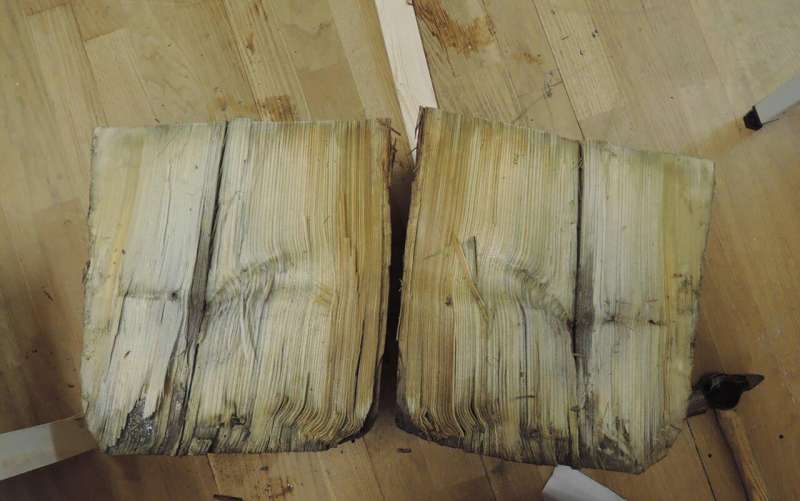
As early as 2,000 years ago, the great Roman architect Vitruvius wrote that wooden piles must be driven down into mud or waterlogged ground and buried completely in order to create a stable foundation for buildings. A new thesis from the University of Gothenburg shows that wooden pile foundations show visible damage after only a year if the groundwater level lowers.
Many of the older buildings in Gothenburg were constructed on foundations of wooden piles. As long as the piles are completely surrounded by waterlogged, wet clay, they are very durable, because the wood breaks down very slowly in an anoxic environment. But if the mud starts to dry out, soft rot fungi can attack the piles, which eventually lose their bearing capacity, and this can lead to progressive settlement of the buildings. This is precisely the topic of a thesis by Johanna Elam at the University of Gothenburg.
“I wanted to investigate how quickly new local groundwater conditions affect the degradation of the wood in clay soil. We have been able to show that soft rot fungi only grow above the groundwater level and that bacterial degradation is less the further below the groundwater level the wood lies,” says Johanna Elam.
Soft rot fungi need oxygen
The biggest enemies of wooden piles are soft rot fungi and bacteria. Soft rot fungi can lie latent on the wood surface and in the soil, and only begin to attack the wood when they come into contact with oxygen. Degradation of the wooden pile can then take off and reduce its strength within a relatively short period of time—in the worst case within just a few years. Degradation due to bacteria, on the other hand, takes several hundred years, despite the fact that it continues the whole time, even in anoxic environments.
Johanna Elam investigated wooden piles and measured the environmental conditions under eight buildings in Gothenburg. In addition, she simulated a range of groundwater conditions in laboratory experiments to better understand the effects of a lowered water table. These days, a certain amount of groundwater lowering is often permitted, as it is deemed to be risk-free.
Degradation visible after one year
“In lab experiments I saw that degradation is already visible on wooden piles after 12 months where the groundwater level had been lowered and the surrounding clay was no longer waterlogged. The samples taken from the piles under the buildings have all managed to escape rot, which indicates that the groundwater level and the anoxic environment have been maintained over time,” says Johanna Elam.
Today, a fall in the groundwater level of no more than 30 cm around construction sites is often a requirement. However, a 30 cm fall in the groundwater level can be enough to cause serious damage to a wooden pile if the fall occurs over a long period of time. The worst degradation of the wood occurs just above the surface of the water table, although it takes quite a long time for oxygen to penetrate down into a clay soil that has dried out. Some results also suggest that if the groundwater flows around the wooden pile, this can bring oxygen with it that causes soft rot fungi to take off.
“To protect the wood, it should be either 100 percent wet or 100 percent dry. I therefore recommend that excavations be properly sealed off so that the groundwater levels are maintained outside the excavated area. It’s better than pumping water in, which risks increasing the movement of water and thereby bringing in oxygen,” says Johanna Elam.
Tips for building owners:
- Take samples of existing wood foundations before a construction project starts on a neighboring property so you can assess the extent to which the wood is already degraded and how protective the environment is.
- Consider reinforcing the foundations if there is a high risk of damage due to settlement.
- If you have a crawl cellar with earth floor, lay flooring to protect the earth from drying out rather than installing a dehumidifier or water pump. Laboratory tests showed that covering the soil surface resulted in less drying out and less degradation of the wood.
The thesis is titled “Microbial degradation of wooden foundation piles in urban context—causes and concerns,” and is available online.
Citation:
A small lowering of the groundwater level can destroy house foundations (2022, June 20)
retrieved 20 June 2022
from https://techxplore.com/news/2022-06-small-lowering-groundwater-house-foundations.html
This document is subject to copyright. Apart from any fair dealing for the purpose of private study or research, no
part may be reproduced without the written permission. The content is provided for information purposes only.
Stay connected with us on social media platform for instant update click here to join our Twitter, & Facebook
We are now on Telegram. Click here to join our channel (@TechiUpdate) and stay updated with the latest Technology headlines.
For all the latest Technology News Click Here
For the latest news and updates, follow us on Google News.
